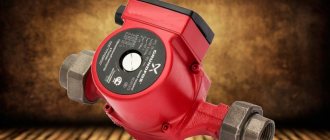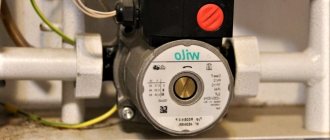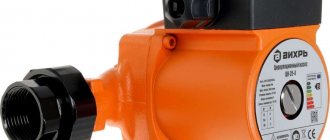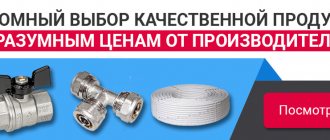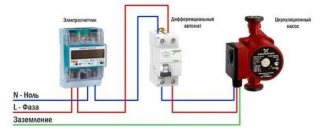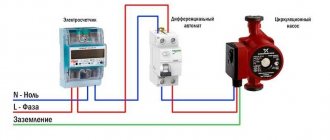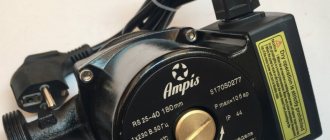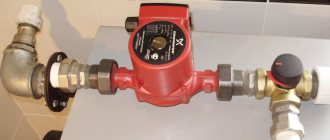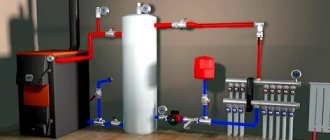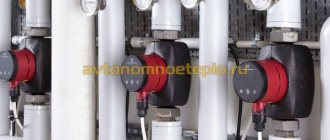What is a circulation pump
The heating circulation pump is a compact device that fits directly into the pipeline of the autonomous heating system. Thanks to an electric motor that drives a spherical rotor with an impeller, such a unit can significantly increase the circulation speed of the coolant in a closed circuit. And this, in turn, makes it possible to accelerate the heating of fairly large areas.
The design of the circulation pump unit can be different, but as a rule, it includes the following main components and parts:
- Electric motor.
- Spherical rotor.
- Stop valve.
- Check valve.
- Frame.
- Thermal insulating casing.
- Thermostat.
- Power supply plug.
In addition, the device can be equipped with an operating status indicator, a timer and some other service devices and instruments.
Equipment design
The design of circulation pumps for heating systems is designed to ensure forced movement of the coolant liquid. To do this, the power base of most of these units is equipped with motors - in particular, an asynchronous single-phase drive, which uses the function of the impeller. In addition to the electric motor, the typical design of pumps for heating boilers contains the following components:
- Housing provided with connecting fittings.
- Screws for fastening.
- Connections for draining condensate.
- Regulating devices.
- Terminal block for electrical connection.
- Indicators, control buttons and switches.
- Adapter fitting and other adapters.
Technical versions of pumps of this type may differ in a variety of parameters. In particular, by the type of lubrication of the engine rotor block. There are “wet” and “dry” designs. In the first case, the mechanics are lubricated by flowing coolant, and in the second case, by special technical oil. The second option is less attractive for the reason that particles of machine lubricant may remain in the water, and this affects the environmental purity of the water. However, for heating systems this factor is of little significance.
Need for use
If in city central heating lines the water pressure is regulated by special centralized substations, then when equipping an autonomous heating and hot water supply system for a country house, a circulation pump device is an absolutely irreplaceable unit. Especially if we are talking about a fairly large building. The fact is that it is capable of “accelerating” the heat supply of a closed circuit in almost any conditions and in any weather.
Without forced circulation, the heating system tends to “heat up” for a very long time. This is especially true in cases where a country house is used not every day, but from time to time. In these cases, a heating circulation heat pump is able to create an optimal microclimate in much less time. Thus, in many cases it is simply impossible to overestimate the value and importance of this unit.
Review of the best manufacturers
To perform such manipulations, a special formula was developed, it looks like this: Q = 0.86 x P/dt. But the result obtained will not be final; changes are made to it regarding the height of the radiators and communications; the return line is unable to balance the data.
Not a single circuit is immune from hydraulic resistance, no matter how well it is created; these amendments can be easily made if you have the skill of working with heating equipment.
The passport for brand products always indicates performance graphs; this data can clarify the overall picture and help in further manipulations.
Types of circular heat pumps
Despite the differences in modifications presented on the market today, experts divide them into two main classes:
With a “wet” rotor.
With a “dry” rotor.
As the name implies, the “wet” rotor comes into contact with water circulating in the closed circuit of the heating system. In the vast majority of cases, pumps of this type are installed in country houses, dachas, cottages and other individual housing construction projects.
Among the main advantages of modifications with a “wet” rotor, the following should be highlighted:
- Long service life.
- Unpretentiousness during operation.
- Ease of maintenance and repair.
- Low noise level during operation.
- Compact size and light weight.
- High energy efficiency indicators.
- Relatively affordable price.
However, pumps of this type also have some disadvantages. The main one is the relatively low efficiency rates, amounting to approximately 50% and even lower. That is why, for forced circulation of coolant in heating systems of large areas, the use of a “wet” pump becomes impractical and ineffective.
Autonomous heat supply systems for apartment buildings, residential complexes and large industrial buildings involve the use of devices with a “dry” rotor. The body of such a pump does not come into contact with the coolant, and forced circulation of liquid in the system is carried out using special blades. The efficiency of such a unit can reach 80%. However, the noise emitted by a unit of this type during operation requires not only its installation in a separate room, but also additional soundproofing measures.
About connecting other devices
When working, you must follow some simple rules so that the system works as efficiently as possible.
- All threaded connections must be additionally sealed with sealant and rubber gaskets.
- Ball valves should be installed on both sides of the pump. Thanks to this, if necessary, you can dismantle the device as quickly as possible.
- Wet pumps must be installed exclusively in a horizontal position. Otherwise, if the motor is not completely immersed in water, the working surface of the device may be damaged.
- A filter should be embedded in front of the device - it will protect it from mechanical impurities that are invariably present in the coolant.
- When installing, follow the direction indicated by the arrow drawn on the pump. The arrow should point in the direction in which the hot coolant will move.
- Install an air valve on top of the bypass, which in the future will help you remove foreign air from the system.
Also remember that the pump should only be connected to an outlet that has a ground connection. Therefore, you must first provide this grounding.
Main characteristics
When choosing a circulation pump for an autonomous heating system, you must pay primary attention to the following technical characteristics:
- Device performance, maximum operating pressure.
- Operating coolant flow rate in cubic meters.
- Unit power.
Obviously, the parameters that the pump must meet largely depend on the characteristics of the autonomous heating system, as well as on the characteristics of the building and structure, the climate zone and many other subtleties and nuances.
Therefore, before choosing a circular heat pump, it is necessary to calculate the required power of the unit.
Power calculation
Calculating the power of a heat pump is a rather complex process that requires not only sufficiently deep theoretical knowledge and rich practical experience, but also taking into account many aspects and nuances. Therefore, it is most advisable to entrust such calculations to highly qualified specialists. However, there are general principles on the basis of which power can be calculated. True, these calculations will be quite approximate.
There are two calculation methods:
- European. According to it, each square meter of an individual household should receive 100 W of heat, and an apartment complex – 70 W.
- Domestic. For low-rise housing (1-2 floors), it provides for the need to obtain 173 W of heat at a temperature of -25 degrees and 177 at -30. For multi-storey buildings, these indicators are set at 97 and 101 W, respectively.
Of course, in addition to power, the pressure in the system and its configuration itself are also important. That is why it is customary to entrust all calculations to experts from specialized companies. Professionally made calculations allow not only to fully satisfy heat needs, but also to avoid unjustified expenses, as well as unnecessary overloads of the system or, conversely, its idling.
Installation of a heating system circulation pump
It is best to entrust the installation of a circular pump to a heating system, as well as all technical calculations, to qualified specialists. Since installation of a unit with a “wet” rotor involves inserting the device directly into the pipeline, this will require not only theoretical knowledge, but also practical ability to work with specific tools and equipment.
However, we will provide step-by-step instructions for installing a rotary pump in a pipeline.
Step-by-step instruction
Let's start with the fact that if tie-in work is carried out in winter, that is, when uninterrupted operation of the heating system is necessary, then it is necessary to organize a so-called bypass - a temporary workaround that allows the heating system to operate in natural circulation mode.
The basic algorithm for installing the pump itself is as follows:
- It is necessary to pick up the assembled unit and point the marking arrow marked on it towards the heating boiler.
- On the right side, first the filter is screwed on, then the tap, after which a threaded angle with a tee is installed.
- On the left side, the same operations are carried out, with the exception of installing a filter - there is no need for it here.
- After which all that remains is to connect the resulting structure to the pipe, and the pump itself to the power supply.
However, pump installation looks simple and smooth only on paper. As a rule, such work requires cutting pipes, installing ball valves, connecting elements, and sometimes welding. Experienced specialists will cope with this much easier and faster.
Analysis of installation technology
The installation process itself is quick; to secure the housing, you need to secure two union nuts. This is very convenient for further maintenance and repair work. But before installation, it is necessary to choose the right installation location, otherwise the pump will either work intermittently or will soon fail.
Schemes for inserting a pump into the network
When choosing one of the schemes, it is necessary to take into account the type of heating system, boiler model and ease of maintenance.
Option 1. This is the most common solution: the pump is mounted on the “return”, through which the cooled coolant returns to the boiler. Warm water does not have such an aggressive effect on the parts of the device, so it lasts longer.
A good place for installation is between the membrane tank and the heating boiler. This circuit is universal, it is equally good for open and closed systems, as well as for connecting devices using the collector method (+)
Option 2 . This solution is relevant if for some reason it is not possible to install a pump on the return line. Then it is fixed at the beginning of the circuit, at the supply, but not near the boiler, but after the safety group.
Modern devices can easily withstand high temperatures, but there are still experts who reject such a scheme.
Shut-off valves are ancillary items and are required for quick maintenance. To remove the circulation pump, you need to unscrew the taps located on both sides of the housing (+)
There is such a heating network option as an open system with an expansion tank installed at the highest point of the circuit.
If you install a circulation pump, you will be able to operate it in two modes: natural and forced. Natural circulation will come in handy if there are power outages.
To be able to switch the system from one mode to another, the circulation device is installed not on the pipe, but on the bypass - a special outlet. When the pump is turned on, the pipe is closed with a tap
The last scheme applies only to networks with a solid fuel boiler. The supply pump is not installed due to the risk of explosion. The fact is that with solid fuel boilers it is impossible to quickly stop the heating process, as a result of which the water boils.
Boiling water with steam gets inside the pump, it reduces productivity, the cooled water in the circuit does not have time to flow back into the boiler in the required quantity - and it heats up even more. The result of overheating is an explosion.
A thermal mixing valve becomes an additional element of the network. It serves to switch the coolant circulation from a small circle (with bypass) to a large one (+)
If you run cooled water from the circuit into a heating boiler, condensation will form. To prevent this from happening, the water is first heated in the small circuit to +55°C, and then the thermostatic valve smoothly switches to the large circuit.
As a result, cold water is mixed with already heated water and “temperature shock” does not occur for the boiler.
How piping is done
The circulation pump piping is the equipment necessary for its proper functioning, as well as for the smooth operation of the entire heating system.
First you need to finally decide how many pumps there will be. For one simple circuit, one device is enough, but with complex wiring it is possible to install two or more.
If you plan to use a “warm floor” system in your house or install an indirect heating boiler, then it is better to increase the number of appliances to two. If two boilers are installed - solid fuel and electric - you will also need a separate pump for each unit.
Correct (top) and incorrect (bottom) pump installation options. If you choose the wrong position and move the rotor axis from horizontal, airing or overheating may occur (+)
As mentioned above, ball valves are mandatory elements. They are mounted together with the pump, and in the event of an emergency, they will have to be used.
A check valve made of brass or cast iron is also required so that the coolant moves in one given direction. It is mounted on the pipe immediately after the pump, in the direction of water movement.
A “dirt filter” will be required to prevent solid particles from entering the device housing. Fine filters are not installed in heating circuits. If clean water is needed, it is pre-purified before being poured into the system.
There is a risk of air getting into the network, so there is a need to install an air valve. It can turn on automatically, but there are also manual models.
Using a fitting, a pressure gauge is installed at a short distance from the pump, sometimes two identical devices are installed on both sides. With their help, they monitor the correct operation of the circulation unit
After installing all the devices, the pump is connected to power. A big mistake is to use an ordinary outlet without grounding. This is a safety violation and can cost lives in the event of an accident.
There are smarter ways to power power:
- via uninterruptible power supply (UPS);
- through a differential circuit breaker;
- by connecting to the boiler automation.
The easiest way is to use a circuit breaker: you will need an 8 A switch itself, contacts, and wires. But for practical use, a solution with a thermostat is very convenient.
Connection diagram with thermostat. When the coolant temperature in the network drops below a certain value, the thermostat operates and turns off the power supply (+)
If you plan to install a UPS, you can connect an uninterruptible power supply to both the pump and the boiler at the same time.
Popular models and prices
As mentioned above, the most common and popular type of circulation pumps for autonomous heating systems in country houses are units with a “wet” rotor. Today there is a wide variety of models from different manufacturers on the market. Depending on the design, technical characteristics and service capabilities, the cost of a circular heat pump can be different amounts.
Today in Moscow you can buy a circulation heat pump as a “budget” version - the cost of such a unit is in the range of 5,500–7,000 rubles. Equipment manufactured under the popular brands Grundfos or Vilo, with such an affordable price, ensures quality, reliability and durability.
There are also more productive models, characterized by high power levels and rich service capabilities in the form of indication of operating parameters, various automatic functions, and so on. The cost of such pumps can reach 12 and 15 thousand rubles.
Drainage pumps "Oasis"
The Oasis submersible drainage pump with DN marking is used when pumping dirty water from the basement floors of buildings, basements, trenches, ditches, artificial reservoirs or for pumping clean water. Devices are divided into two types - for pumping dirty and clean water.
Drainage pumps Oasis
Units of this type have the following general characteristics:
- maximum diving depth – eight meters;
- electric cable length – 10 m;
- max size of filtered particles, mm: 5 (for DN with clean water), 35 (for DN with dirty water);
- The material of the unit impeller is plastic.
Drainage pumps designed to work with clean water have power parameters ranging from 200 to 660 W, maximum performance of 110 to 220 l/min and maximum head of 6 to 14 m.
The body of these devices is made of plastic. The most common models: DN 110 6, DN 170 9, DN 220 14.
Drainage pumps used for pumping dirty water have power parameters ranging from 110 to 880 W, a maximum flow rate of 150 to 266 l/min and a maximum pressure of 6 to 11 m.
The body of such units is made of plastic or stainless steel. The most popular models: DN 150 6, DN 175 7, DN 266 11.
